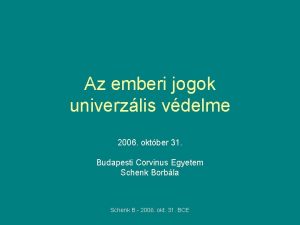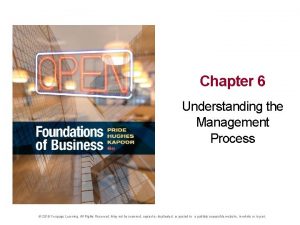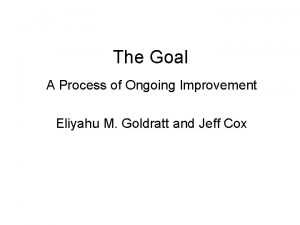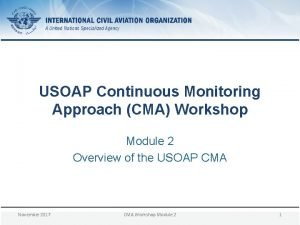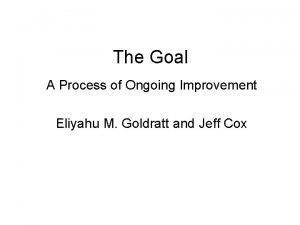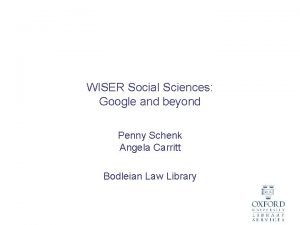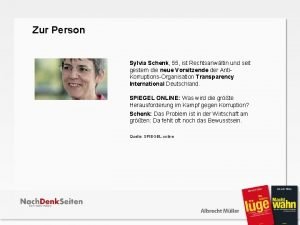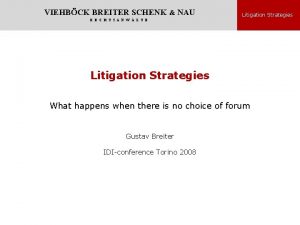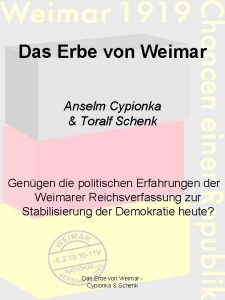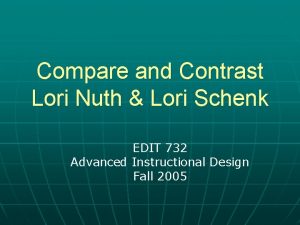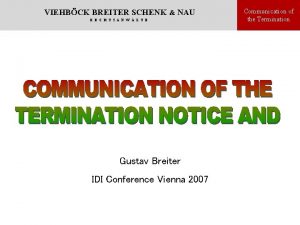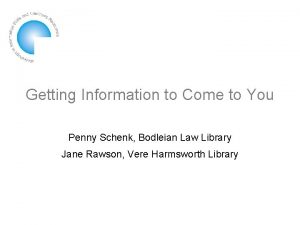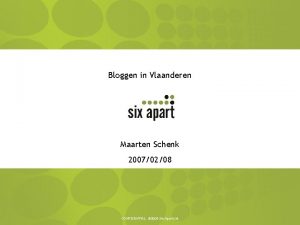Status update on ongoing studies M Schenk for


















- Slides: 18

Status update on ongoing studies M. Schenk for EPFL PACMAN team EPFL & CERN, Switzerland Acknowledgements M. Giovannozzi, A. Mereghetti, B. Salvachua, M. Solfaroli, R. Steerenberg, J. Wenninger PACMAN Project Meeting

Overview Three parts 1. LHC: beam lifetime / losses and emittance surrogate model 2. SPS: electro-static septum alignment 3. PS: injection bump optimization 2 02. 12. 2019

LHC: surrogate model for beam lifetimes and emittances L. Coyle, E. Krymova, G. Obozinski, A. Pentina, T. Pieloni, M. Schenk EPFL & CERN, Switzerland PACMAN Project Meeting

LHC surrogate model Overview / reminder Objectives • Build online surrogate model for LHC machine configurations based on simulations (single- and multi-particle dynamics? ) and experimental data • Include dependencies on main machine and beam control parameters • Model that grows in complexity over time (more parameters, larger range) Motivation • Working point optimization wrt. beam lifetime / losses, emittances • Preparation in view of LHC Run 3 Plan / status 1. Produce dataset from simulations (ongoing software development to get going with Sixtrack/BOINC machinery) 2. In parallel: use existing LHC data, build upon work done by Loic • • Group of students from EPFL ML course currently working on dataset (black-box model approach, very short-term project) Develop more thorough model together with SDSC 4 02. 12. 2019

LHC surrogate model Status in more detail (for discussion) Point 1: Simulations • Original idea: loss prediction through dynamic aperture scaling laws by M. Giovannozzi et al. ; allows in principle extrapolation to “any” time scales • Complicates matters: theory development not yet complete (several fit models, uncertainties, error propagation, …) • We are mostly interested in short-term evolution (up to ~106 turns) Þ quantify short-term loss directly using aperture model in Sixtrack Þ ongoing work by Loic: implement aperture model and get BOINC machinery “ready for production” (Sixtrack / BOINC managers now in Python: more versatile for our studies) 5 02. 12. 2019

LHC surrogate model Status in more detail (for discussion) Point 2: LHC data • Limitations of existing datasets • OP data: low variance (“once you find good settings, stick to them”) Þ Good test set performance not necessarily representative for model quality Þ One reason why model trained on 2017 data not applicable to 2018? • MD data: high variance in tunes, but not enough time to explore more parameters • Some data not continuous (e. g. bunch-by-bunch emittance), transient effects: requires preprocessing / interpolation / fitting … • Involved dynamics: do we have access to all relevant features? • Pure black-box model not desirable • “Why let model learn something by itself that we already know” • Particularly true given limited amount of data • Better: provide prior knowledge • Include analytical relationships between output / input or related quantities • “Fill in the gaps” with simulation data, even if just qualitative dependencies • Not obvious how to incorporate due to complexity (more iterations with SDSC) • Ideally model should only use control parameters as inputs 6 02. 12. 2019

SPS: electro-static septum alignment M. Schenk�, M. Fraser*, B. Goddard*, S. Hirlaender*�, V. Kain*, T. Pieloni� *CERN & �EPFL, Switzerland �also at University of Malta PACMAN Project Meeting

SPS: electro-static septum alignment Overview / reminder Electro-static septum (ZS) for slow extraction • Lossy process: particles scattering off anode wires • Reduce losses through anode alignment • So far, done manually (time consuming ≈ 8 h) • End of 2018: automatic alignment with optimizer Slow extraction => time reduced to 40 min. Optimizer has no memory: use reinforcement learning agent instead? action agent environment (e. g. accelerator) state (observation) reward model from measurements • Agent training may require many iterations • ‘Too expensive’ on the machine => create model of ZS from existing data for offline agent training • Once machine back in operation: pre-trained agent should adapt to real environment quickly 8 02. 12. 2019

SPS: electro-static septum alignment Objectives / steps • Create model of losses as function of anode wire positions (9 dof) • Perform sanity checks • Train RL agent and validate • Does agent adapt to real environment in a few iterations? (=> future work…) Outputs F(x) Beam loss (Gy/charge) Inputs BLMs Modeling strategy • Black-box approach • Supervised learning • Neural network: • 2 hidden layers (various numbers of nodes) • 20 % dropout 9 02. 12. 2019

SPS: electro-static septum alignment Model sanity checks Model response (total loss) as function of anode positions Observations • Loss response convex • Relatively weak dependence on total loss 2 hidden layers (80, 40) nodes from ZS 4 and ZS 5 • Strongest impacts from ZS 2 and ZS 3 • Model quite robust to changing NN topology All in accordance with what we know about the system from past experience 10 02. 12. 2019

SPS: electro-static septum alignment Summary of numerical optimizers Anode position (mm) BOBYQA Norm. losses (10 -13 Gy/charge) • Optimisers probe feature space not just along orthogonal directions • Good test for sanity of model: it behaves well • All methods either find or go towards an optimum Anode position (mm) • COBYLA (linear approx. ) and BOBYQA (quadratic approx. ), both constrained algorithms, perform best in terms of number of iterations • Bayesian optimisation takes more iterations and executes slowly. Advantage COBYLA Bayesian optimisation is that it builds model on-the-fly (it would perform better in future runs) • Algorithms converge to different final anode configurations: partially explained by weak loss response to ZS 4 & ZS 5 anode positions Norm. losses (10 -13 Gy/charge) Anode position (mm) Powell method 11 02. 12. 2019

SPS: electro-static septum alignment RL agents: Normalized Advantage Function (NAF) Normalized Advantage Functions (NAF) algorithm • Extension of DQN (Deep Q Network RL) • Assumes specific shape of Q, V functions (e. g. quadratic) • But this also reduces representational power g T # iterations g nin reward # iterations i Tra in est average reward Cumulative reward Number of episodes 12 • Trained agent typically finds back optimum in few iterations • Occasionally it does not (abort after 10 it. ) • Training success depends on constraints in initial anode positions (here [-0. 5, 0. 5] mm) … 02. 12. 2019

SPS: electro-static septum alignment RL agents: Deep Deterministic Policy Gradient (DDPG) Avg. reward p. ep. Avg. #interactions p. ep. TD 3 (a Deep Deterministic Policy Gradient alg. (DDPG)) • Works also with relaxed constraints on initial anode positions ([-1. 9, 1. 9] mm) • Important for success: abort episode when outside permitted anode positions 13 Reward goes up with #interactions agent learns successfully (max. reward is at -7. 5) Reaches value close to 1 i. e. agent finds solution in just 1 step, starting from random init. of anode positions in [-1. 9, 1. 9] mm 02. 12. 2019

PS: injection bump closure M. Schenk, A. Huschauer EPFL & CERN, Switzerland PACMAN Project Meeting

PS: injection bump closure Turn 0 Overview 15 End of bump collapse BP M • Objective: can we reduce orbit leakage by adjusting amplitudes and time delays of the four bumpers (without changing signal shapes: defined by hardware) 43 • Four bumpers of interest: BSW 40, BSW 42, BSW 43, BSW 44 • Approximate half-sine waves (2 ms) • Issue: orbit leakage – bump is not fully closed 02. 12. 2019

PS: injection bump closure Reproduce observation in MAD-X Closed orbit matching Step 1: • Match to measured closed orbit (CO) employing corrector dipoles; 4 injection bumpers are off • MAD-X finds good correction: orbit well reproduced at BPMs Step 2: • CO corrector strengths fixed • Match 4 bumper strengths to measured orbit at every turn during bump collapse (done with cpymad) • Solution exists that reproduces measured orbit leakage (with only small correction on top of measured bumper waveforms) 16 02. 12. 2019

PS: injection bump closure Orbit optimization k. Amp Δt initial state Σ = 1. 3 m • Constrained optimization • Objective: minimize sum of absolute differences wrt. closed orbit of all BPM signals (except BPM 43) over time (Σ) • At every iteration, run MAD-X Twiss, compute Σ, and adjust time delays / amplitudes (7 dof) • No change of BSW shapes allowed final state Σ = 0. 7 m • Significant reduction in Σ, but final result not entirely satisfactory • Leakage likely due to bumper shapes: cannot be corrected with only time shifts and amplitude scaling 17 02. 12. 2019

PS: injection bump closure Improved bumper waveforms & working optimizer initial state Σ = 1. 1 m final state Σ < 0. 04 m • Use same waveform for all four bumpers (including overshoots), rescaled to correct amplitudes • Use optimizer on amplitudes and time delays for fine tuning • Result is a near-perfect orbit evolution Conclusions • Orbit optimization based only on amplitude rescaling and time delays not entirely successful • New PS injection system currently being implemented • More degrees of freedom available for automatic optimization of PS orbit during injection => create tool for control center 18 02. 12. 2019
 Is an alternative of log based recovery.
Is an alternative of log based recovery. Schenk borbála
Schenk borbála Stellingen gezonde voeding
Stellingen gezonde voeding Project status examples
Project status examples Fsu freight status update
Fsu freight status update What are the nursing process
What are the nursing process Brigance readiness activities
Brigance readiness activities Understanding the management process
Understanding the management process Herbie the goal
Herbie the goal Construction work ongoing
Construction work ongoing Usoap cma
Usoap cma Past continuous and future continuous tense
Past continuous and future continuous tense A process of ongoing improvement
A process of ongoing improvement Consumer behavior chapter 8
Consumer behavior chapter 8 Initial planning in nursing process
Initial planning in nursing process Ongoing or on-going
Ongoing or on-going Ongoing professional practice evaluation template
Ongoing professional practice evaluation template Focus or ongoing assessment
Focus or ongoing assessment Paradigm shift from women studies to gender studies
Paradigm shift from women studies to gender studies

